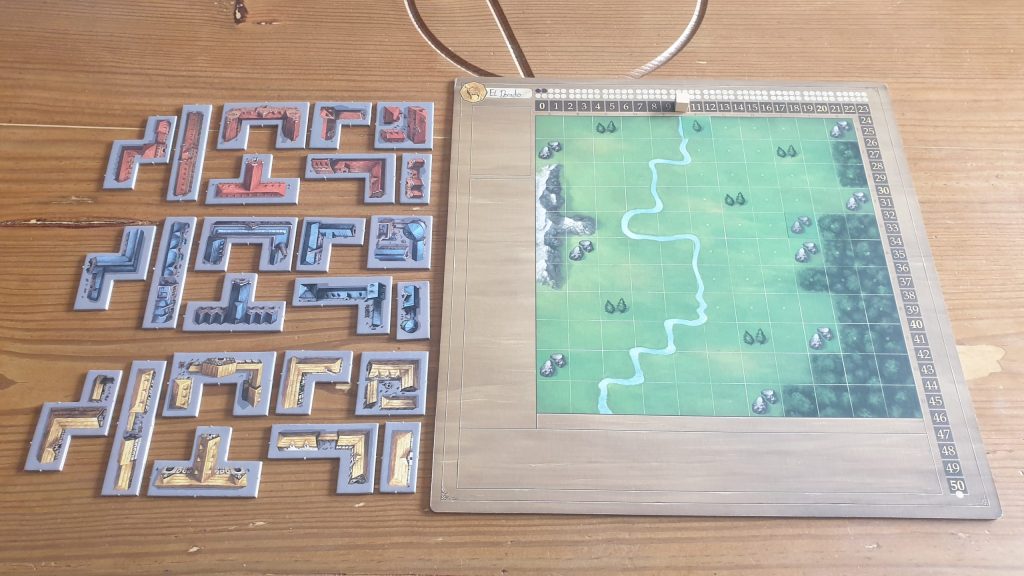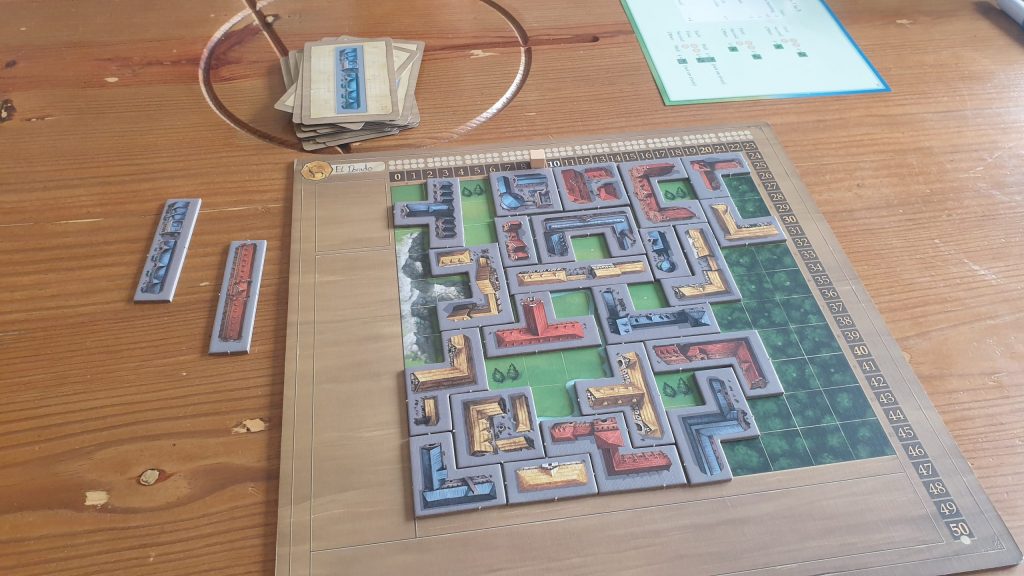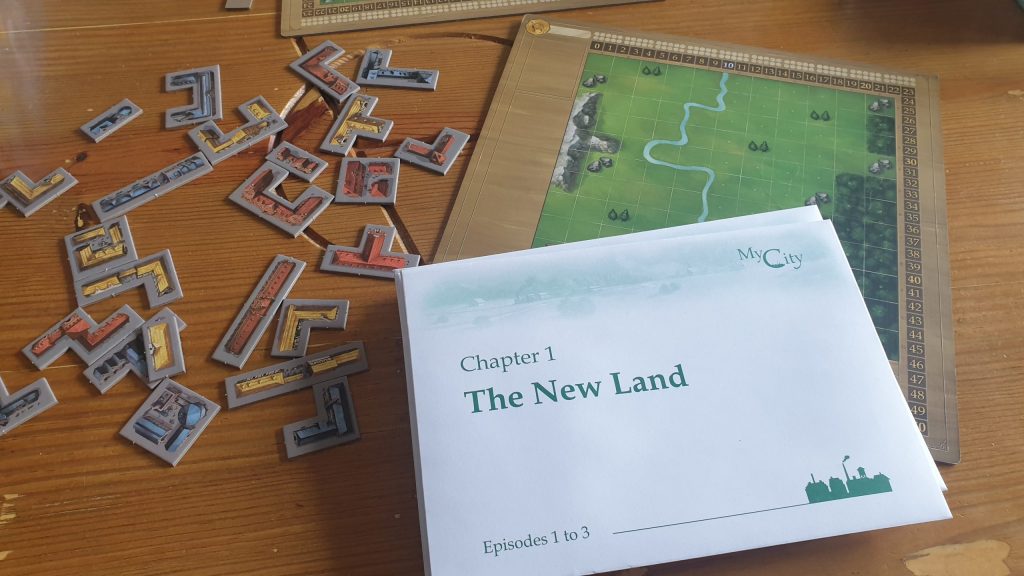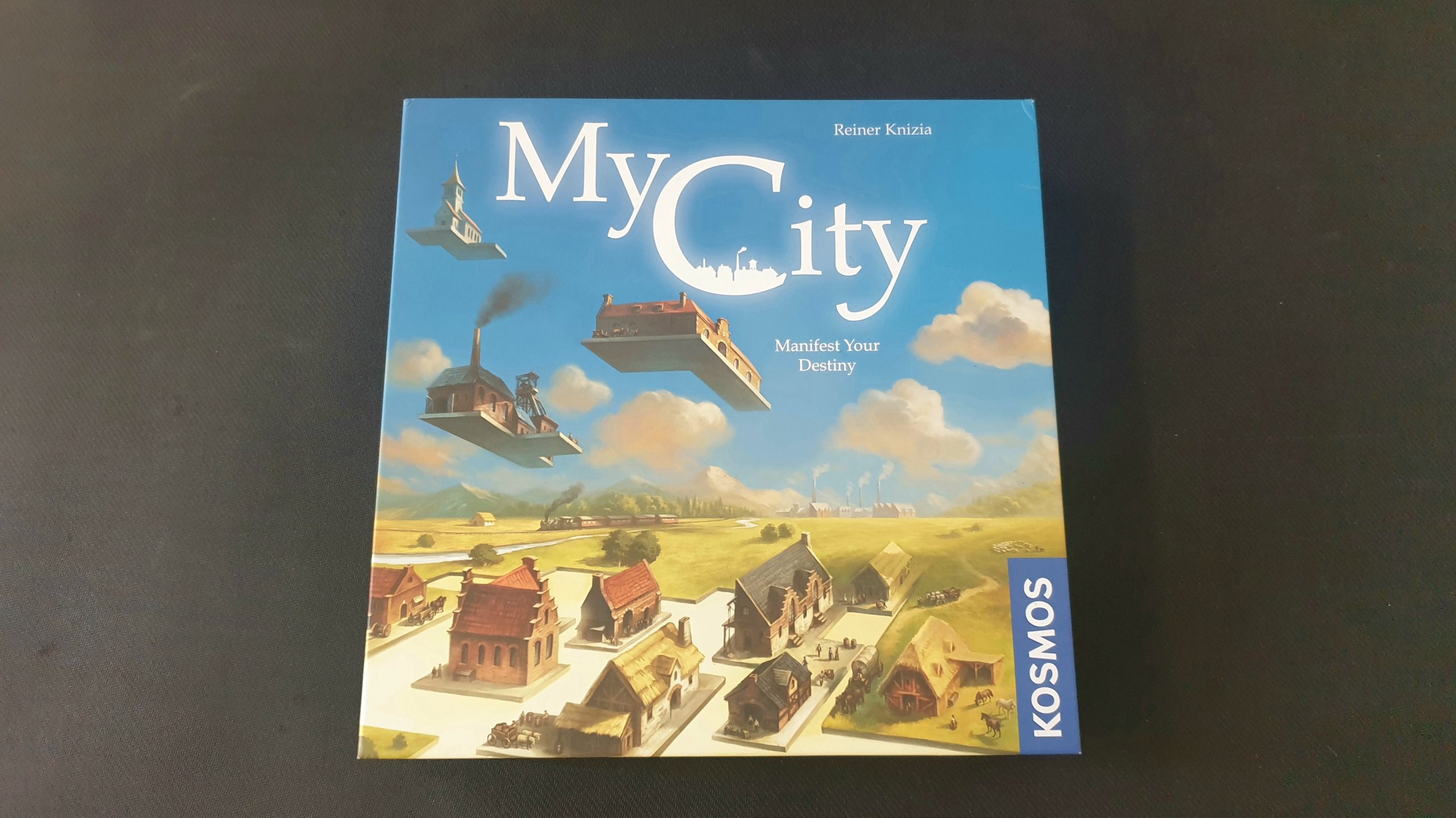My City is a brand new legacy style city building game, from well known designer Reiner Knizia. Published by Kosmos, the game sees cities built up from polyomino shaped tiles, akin to Tetris pieces. As a legacy game things will change and adapt across an arc of 24 individual games, with sealed envelopes to open at specific times throughout the campaign. The game plays with 2 – 4 players and each individual game takes between 20 – 30 minutes. However, will it feel like you’ve made an entire city? Let’s find out!
Note that this review aims to give you an understanding of what to expect from My City without revealing any spoilers. Therefore it focuses on what players can read in the rulebook and the first envelope – which is opened at the start of game 1. Specific content after this players will have to discover on their own, though the campaign will be mentioned as a whole.
Starting out each player will have an identical player board, a scoring marker and the same selection of red, yellow and blue building tiles. The board is double sided, with a legacy side and an eternal side, which is more for playing post the campaign. Players start with 10 points, placing their scoring marker on the 10 on the tracker around the edge of their personal player board. Turns are simultaneous, so there is no need to determine a starting player. Instead, the central construction deck is shuffled and each turn a card is flipped over.
All players find the tile that matches the image on the card, in both shape and colour, from their personal supply. When adding the first tile onto the player board it must be placed adjacent (not including diagonals) to the river, which snakes down the board. Buildings cannot cross the river, nor can they be built on dense forest spaces, mountain zones or on top of other buildings. They can be built on the standard green grass spaces, and over trees and rocks. Once a building is placed it cannot be moved, with future tiles needing to be placed adjacent to previously placed tiles.

If a player doesn’t wish to place a tile, or cannot place it but wants to continue playing, they can skip the tile at the expense of a point. If they cannot place a tile and don’t wish to continue they can announce they are ending their participation in the round. The game continues until either all players have dropped out or the deck runs out. At this point, players then earn and lose points based upon the city they have built. Players will gain a point for every tree that hasn’t been built over and lose one point for every rock and green space that are still showing.
For winning the first game, the player with the most points will earn themselves two progress points. These are dots along the top of the personal player boards, which get coloured in when earnt. The winner will also gain a sticker for their player board. Unfortunately for them it features two rocks – so a slight disadvantage for the next game. If playing with 3+ players the player in second place gains only 1 progress point. All other players, or the loser in a two player game, get no progress points. They do however get a single tree sticker, which can be seen as a slight advantage for future games. The aim of the entire campaign is to obtain the most progress points, with many rules tweaks, additional content, a plethora of stickers and side objective opportunities to grab players’ attention.
The initial games are rather easy, and they are over a lot quicker than the 30 minutes indicated on the box. This isn’t necessarily a bad thing though, as it allows people to play while learning. Stepping in a few rules each game, the first couple of games don’t hugely matter. For a legacy game where there is an overall winner this helps everyone feel like they aren’t instantly out of contention. Especially for the first time players get hands on with the game it is key that there aren’t big changes or advantages from winning that first game. In fact, the way a number of the legacy elements work means they are built in catch up mechanisms, with it being rare for one player to win too many games in a row.
When players are into the swing of things, playing a few games back to back, it’s possible to fit 3 games into an hour. Towards the end of the campaign, when there are a few extra things to think about, this does reduce to 2 an hour – still My City is a relatively short and sweet experience. While we played at 2 this wouldn’t drastically increase with more players, due to the simultaneous play – which makes it feel like a flip and write. With 2 players the awards for winning and the bonus for losing are very black and white. With 3 or 4 players, which opens up 2nd place prizes, this line would be slightly blurred. Even though a lot less of the sticker content is used, note there would probably not be enough stickers for 2 players to play through the campaign twice.

Unlike a lot of polyomino tile placement games, such as Barenpark, the building tiles in My City are one sided. As a result, players cannot flip them, instead only rotate them. This makes the spatial puzzle a bit harder as players see an L shaped gap in their city but aren’t always able to fill it – with the L’s available to them pointing the wrong way. Coming from playing other games this does add a bit of a challenge in, though after a game or two of My City you’ll be able to pre-plan knowing if things will fit.
The way the legacy campaign content is slowly introduced will enable My City to appeal to a wider audience. Broken down into 8 chapters, each has 3 episodes or games. Each chapter has its own envelope to open, which brings in a new rules sheet, sticker sheets and maybe more. This means that when a new chapter is reached a bigger change occurs, with smaller tweaks from the episodes. This allows the game to stay fresh throughout, without it drastically changing from the core enjoyable gameplay.
Not everything about the legacy content is perfect. While the content does to some extent mirror the progression of a growing city, there is very little story to link the games together. While a strong narrative isn’t necessary, it leaves the additions to My City feeling like simply mechanical extras. Some have thematic logic behind them, making sense of the side objectives players will uncover. Still, a little extra linking would have boosted the experience.
There are limitations to where stickers can be placed on the player boards, to make sure future legacy content isn’t interfered with. There was the uncertainty throughout though of not knowing if chosen placements would be good or bad for future games. Looking back while some made things a touch more awkward, they never truly hindered players – especially the bonuses received for coming last in a game.

By the end of the legacy campaign there is a slightly odd feeling of this is my customised board, my land, but not My City. Being rebuilt game after game the city only evolves with the introduction of new elements via the legacy content, and rarely by the choices made by players. The choices did impact the subsequent games, which is to be praised – though more could have been done to make the cities different, even if it was only visually.
The tiles of my city are deserted, as if the life of the growing cities is nonexistent. The grey colour around the tiles also does little to make it look like streets surrounding buildings. Therefore, what players get when they have finished a game of My City is not a city full of little details but empty streets: making it look like simple Tetris blocks are placed and not city buildings. This is perhaps a spot harsh as there are many designs of buildings, which adds some character to the boards, but this could have been so much better. More details such as carts being pulled and townsfolk wandering around could have just elevated the visual appearance and brought the cities to life.
Future play is possible via the eternal mode. Alas, it lacks that variety that helped the legacy campaign stay fresh. There is a box full of rules and content that could have helped continue the fun. With only rules from episodes 1 – 5, it allows the game to be enjoyed mostly spoiler free by others – if you wanted to play it with people outside of your legacy campaign. Still, for those that have finished the campaign, the ability to use some of the rules that came up would have enabled much more variety in post-legacy plays.
My City rarely left the table, with there never an occasion where an entire chapter wasn’t completed. The short playtime, the not overly complex ruleset and the simple choices allowed it to be both a chilled game and a legacy campaign at the same time. Now that drive to see what’s next is gone, the eternal side seems a little on the boring side. It would have been great to have seen content from other episodes and chapters randomly thrown into the mix. Still, My City is a title which we have played 24 games of, a real achievement for most modern games. While it isn’t a complex experience, fans of tile placement games will get a lot of enjoyment from the campaign, which makes it very easy to recommend!
(Editor’s Note: My City was provided to us by Kosmos for the review. Check out the official game page here.)

